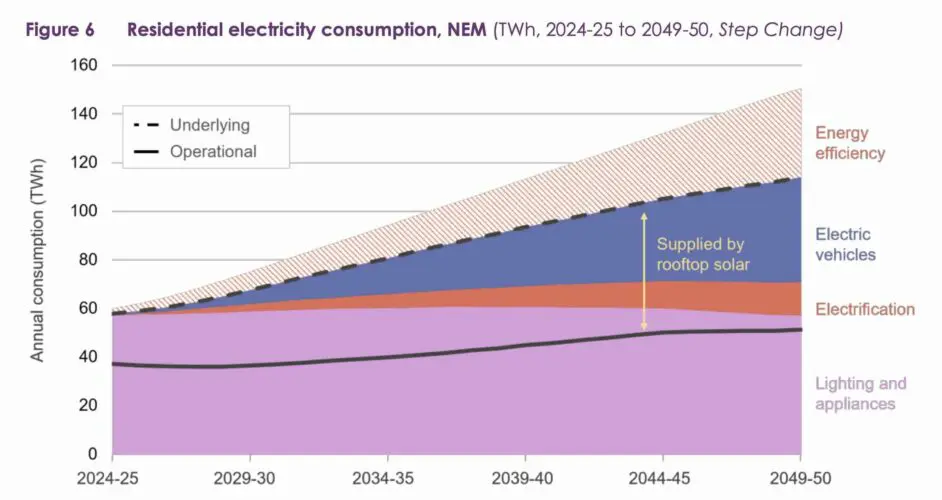Australia’s energy transition: The Crucial Role of Household Energy
According to the Australian Energy Market Operator (AEMO)’s latest report, the 2024 Integrated System Plan (ISP), household energy—particularly rooftop solar, electric vehicles, and home batteries—is set to play a pivotal role in Australia’s electrification process.
Growth Potential of Household Energy Resources
The ISP highlights the significant expected growth in household energy assets. By 2050, rooftop solar capacity is projected to increase from the current 21 gigawatts to 86 gigawatts. Home batteries are expected to expand from 1 gigawatt to 34 gigawatts. Additionally, electric vehicle ownership is anticipated to surge, with an estimated 97% of vehicles on the road being fully electric by 2050. Dan Cass, Executive Director of Rewiring Australia, notes, “The ISP makes clear that the best course of climate action is to double down on progress made already, support the 3.8 million households with rooftop solar and not U-turn towards slow and expensive nuclear baseload power.”
Economic and Environmental Benefits of Electrification
The growth of household energy resources will not only contribute to grid stability and reliability but also reduce energy costs. AEMO CEO Daniel Westerman states, “Consumers are already a driving force in Australia’s energy transition and this is set to continue. If consumer devices like solar panels, batteries and electric vehicles are enabled to actively participate in the energy system, then this will result in lower costs for all consumers.” Coordinating these assets could save $4.1 billion in additional grid-scale storage investments, particularly through the use of home batteries.
The Role of Smart Technology and Virtual Power Plants
AEMO also emphasizes the importance of smart technology in managing household energy assets. Community batteries, household hot water systems, and pool pumps will play a role in managing electricity flow to and from the grid. Virtual Power Plants (VPPs) will be a key part of this future, though it’s crucial that consumers maintain control over their systems to ensure transparency and tangible benefits. “They will need transparency and material benefits to ensure they support, with confidence, their systems being coordinated with the power system,” AEMO highlights.
Future Electricity Consumption Trends
As household electricity demand rises—due to increased use for heating, cooling, cooking, and charging electric vehicles—total electricity consumption is expected to reach 150 terawatt-hours (TWh) by 2050. However, more than two-thirds of this demand will be offset by additional rooftop solar, energy-efficient buildings and appliances, and behavioral changes, reducing reliance on the grid to approximately 50 TWh, similar to current levels. This indicates that household energy assets will significantly reduce dependence on traditional grid infrastructure, supporting the electrification process.


Summary and Outlook
In summary, the growth and smart integration of household energy are crucial for advancing Australia’s electrification efforts. AEMO is rapidly adapting its approach to leverage the potential of consumer energy resources. Stephanie Bashir of Nexa Advisory remarks, “While we are pleased the Final ISP contains greater consideration and quantification of the role of consumer energy contributions, bringing together rooftop PV, Behind the Meter storage and EVs, it is critical to ensure consumers are in control of their assets to reduce their bills and build trust.” Australia must seize the opportunity presented by household electrification to achieve broader clean energy goals.
-
New 1500Vin@380Vout DC-DC Converter Challenges Traditional UPS for Powering Modern Data Centers
The article introduces Maxwell’s MXR150062B-DC2 1500V DC-DC converter, a next-generation solution replacing traditional UPS systems in AI data centers, HPC, and crypto mining. With a wide 800–1500Vdc input range, 98% efficiency, and scalable parallel operation, it enables direct DC architectures that cut costs, boost efficiency, and integrate renewables—making data centers more sustainable and future-ready.
넶0 2025-10-14 -
Power Modules for Hydrogen Production
This article explores power modules in hydrogen production, highlighting Maxwell air-cooled modules (MXR820100B, MXR500100B, MXR400100B). Compared to traditional IGBT systems, they offer higher efficiency, faster response, greater power density, and superior reliability. These advantages improve electrolysis efficiency, reduce energy use, extend electrolyzer life, and support clean, sustainable hydrogen production.
넶5 2025-09-23 -
Development and application of hydrogen technology!
Hydrogen technology is driving the global clean energy transition, with rapid advances in alkaline, PEM, solid oxide, and seawater electrolyzers. As demand for hydrogen charging grows, Maxwell introduces its 100kW AC/DC hydrogen generators (MXR820100B, MXR500100B, MXR400100B). Featuring high efficiency, modular design, and wide voltage adaptability, they enable megawatt-scale hydrogen electrolysis and next-generation EV charging.
넶9 2025-09-18




















